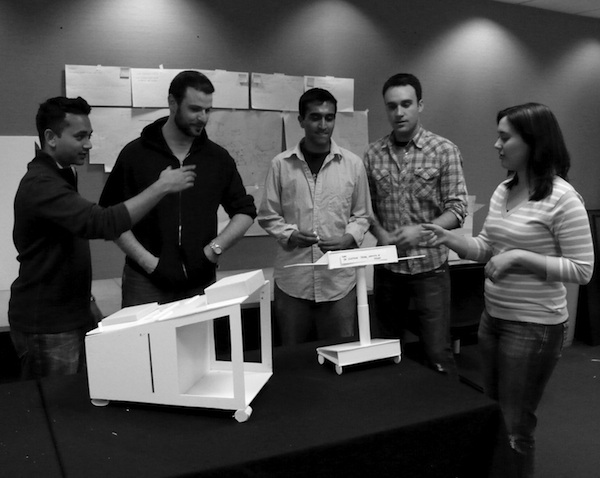Innovation is hard, but less mysterious than you’ve been led to believe. We wrote a book peeling back the veil of design-led innovation, called Naked Innovation: Uncovering a Shared Approach for Creating Value. It’s roughly based on what’s taught at the the IIT Institute of Design and we’re thrilled that it’s being used by Fortune 500 companies, non-profits, government agencies, and academic programs around the world. But we also believe the book hasn’t quite reached its full potential.
To revise it, we’re giving away the first edition for free in exchange for a crowd-sourced critique. To give you an idea of what you’ll find in the book, here are five valuable lessons about collaborative innovation that we learned in the process of writing about how innovation works.
1. Define a shared perspective: what problem are we solving, who are we solving it for, and why
Establishing a stated intent up front enables a team to be more effective together—even when working separately. An explicit conversation about what we’re really doing means we can all stay on track—and, when necessary, helps call out surprising discoveries that take us in new directions. We’ve discovered that when ambitious projects start with ill-defined intent, they all too often end up being disappointing or, worse, never get completed at all. Naked Innovation provides frameworks for establishing a good initial Innovation Intent and for reframing it as you discover more about the problem and the solution space. Make sure you take an opportunity to formally establish what we’re doing, for whom, and why before running off to explore, prototype, or design. Well-defined intent is a lot more important than good intentions.
2. Help your team appreciate the contributions of every discipline
Problems worth tackling take more than one discipline working together to solve: not just coders, but coders, designers, researchers, and maybe marketing experts too. When we each understand what other disciplines are contributing, we can be more accommodating of constraints and more willing to try alternative solutions. In principle that makes sense, but it’s easier said than done. The reality is that it’s easy to be either naïve or overconfident about the power of your own skills.
It can be surprising just how many different pieces of thinking need to come together to bring a successful new innovation into the world. As a team lead, your greatest contribution to your team can be helping them develop “integrative thinking.” (We prefer this term to “design thinking”, as it focuses on the outcome rather than the process.) It can take hard work to develop and deploy a range of approaches for cross-disciplinary communication and collaboration. Naked Innovation provides a baseline set of methods that work across the Balanced Breakthrough Model: a time-tested approach, which shows how to converge insights about people, business, and technology into valuable new offerings.
3. Build tangible prototypes to make feedback easier
Even when individual disciplines begin to respect one another and work together, they tend to talk in field-specific shorthand. Jargon isolates designers from strategists and developers from marketers—the terms just don’t translate easily. You may be better served creating an actual thing—a tangible prototype in a form people recognize or can interact with—to make it easier for everyone to see what you’re talking about, and to contribute valuable feedback. Prototyping, in its myriad forms, is a foundational approach that enables easier feedback from across disciplines and outsider groups like prospects, partners, employees, users, or current customers.
Diagram of the Naked Innovation process
In a sense, the book Naked Innovation is just such a prototype. It’s our view of innovation version 1.0. We’ve pushed innovation beyond the methods we learned at the Institute of Design and made it an approachable narrative for everybody—not just designers—to react to. The collective conversation we’re having with our readers at NakedInnovation.com is giving us direct feedback, paving a path to version 2.0.
4. Fall out of love with your own ideas
Most great innovators appear to be obsessed—just think of Steve Jobs or Elon Musk. So you might think the greatest value is created through single-mindedness and sheer force of will. Determination is part of the story, but there’s a critical, deeper element: flexibility of thinking and willingness to create multiple alternatives is the real hallmark of breakthrough thinking. Successful innovations often seem inevitable (of course thermostats should work like Nest!) but the truth is that success gets shaped by a series of explorations and decisions, which require continuous evolution. If you’re so single-minded that you only see one solution, you’re likely to fail.
When we first started writing Naked Innovation, it was easy to get encouraging input from colleagues who had similar points of view and had positive things to say. But the really useful feedback came from people who didn’t know what we were talking about—and that was a healthy corrective. Sometimes it can be painful to let go of concepts you initially thought were brilliant, but people see what they see. If something doesn’t work, you’ve got to have the fortitude and flexibility to set it aside and try again.
5. Take the long view
Yes, you worked long and hard on it. It was great. But “it” is not the last and final word in the matter. You’re competing with other professionals who will continue to push the solution’s frontier. The only constant is change. Recognizing the long-view enables people and teams to evaluate possibilities not otherwise considered, with new markets or fundamentally new products or services. You’ve got to recognize what’s “next” isn’t what is “final”. Having a stronger position on the long view also enables you to better inform what’s next.
In some ways, we thought we were “done” when we finished version 1.0 of the book. But not everybody reads books. Not everybody reads websites, either. We’re discovering that people are learning more—and participating in a broader discussion—now that we’ve combined a traditional printed book with a website, and have provided video introductions, tweeting, a discussion forum, and other methods of content sharing. We plan to expand the avenues through which Naked Innovation can be engaged and leveraged by innovation teams everywhere.
Visit NakedInnovation.com to join our experiment. There you can download the entire book for free through the end of March, and watch videos introducing the most important concepts from each chapter. We hope you will join in the discussion to share your feedback on the book and your ideas on how to drive effective innovation.










